|
|
 |
|
Calanoida ( Order ) |
|
|
|
Clausocalanoidea ( Superfamily ) |
|
|
|
Scolecitrichidae ( Family ) |
|
|
|
Scaphocalanus ( Genus ) |
|
|
| |
Scaphocalanus affinis (Sars, 1905) (F,M) | |
| | | | | | | Syn.: | Amallophora affinis Sars, 1905 b (p.21); Bradford, 1973 (p.144: Rem.);
? Amallophora gracilis Wolfenden, 1911 (p.265, figs.F);
? Scaphocalanus affinis : Farran, 1929 (p.209, 248, figs.F); Vervoort, 1957 (p.113, figs.F, Rem.); Séret, 1979 (p.113, figs.F);
? Scaphocalanus antarcticus Park, 1982 (p.83, figs.F,M) | | | | Ref.: | | | Sars, 1925 (p.171, figs.F,M); Rose, 1933 a (p.148, figs.F,M); Jespersen, 1934 (p.89, Rem.); Sewell, 1929 (p.205); Hardy & Gunther, 1935 (1936) (p.164, Rem.); Lysholm & al., 1945 (p.27); C.B. Wilson, 1950 (p.324, figs.F,M); Brodsky, 1950 (1967) (p.250, figs.F, Rem.M); Tanaka, 1961 a (p.161, figs.F,M); Arashkevich, 1969 (p.703, figs.F); Park, 1982 (p.76, 77, 82: Rem., 89: Rem.); Gardner & Szabo, 1982 (p.282, figs.F,M); Bradford & al., 1983 (p.93, Rem., figs.F,M); Heinrich, 1990 (p.17, 22: Rem., figs.F); Razouls, 1994 (p.113, figs.F,M, Rem.); Chihara & Murano, 1997 (p.900, Pl.172: F,M); Vives & Shmeleva, 2007 (p.752, figs.F,M, Rem.) | 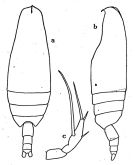 issued from : G.P. Farran in British Antarctic (\\\\\\\"Terra Nova\\\\\\\") Expedition, 1910. Natural History Reports. Zoology. Vol. VIII. Crustacea, 1929. [p.248, Fig.14] Female: a, habitus (dorsal view); b, idem (left lateral view); c, fifth foot.
|
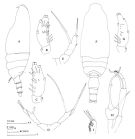 Issued from : J.M. Bradford, L. Haakonssen & J.B. Jillett in Mem. N.Z. oceanogr. Inst., 1983, 90. [p.94, Fig.54]. Female: A, habitus (lateral left side); B, endopod of P2; E, P5; C, endopod of P2 (other specimen); D, P5. Nota: - Posterolateral corners of the last thoracic segment produced into bluntly pointed triangular expansion. - A1 extends shorter than metasome, but in the specimen from New Zealand it extends slightly beyond the metasome, also the posterior surface of the endopod of P2 seems to have a varying number of spinules. - Genital segment with fringed distal margin, slightly swollen ventrally (in lateral view), much shorter than following two segments together. - P5 distinctly 3-segmented with 4 spines, inner edge spine twice as long as segment 3 and terminal spine longer than segment 3, 2 outer edge spines are much shorter. The south-west Pacific specimens have the two distal segments of P5 fused and the length of the outer edge spines varies. Male: F, habitus (dorsal); G, endopod of P2; H, P5; I, terminal part of left P5 exopod. Nota: - Head without crest. - Pediger segments 4 and 5 separated. - Last thoracic segment with rounded posterolateral corners. - Urosomal segment 2 swollen, twice as long as urosomal segment 3. - Right A1 19-segmented. - P5 extends to distal margin of urosomal segment 3. Right P5 endopod reaching almost to exopodal segment 2, with small process on proximal part. Left leg endopod slightly longer than the exopod. - Terminal left P5 exopod has a thin lamella on the outer distal corner and the median surface covered with spinules, but in the specimen of New Zeland
|
 Issued from : G.O. Sars in Résult. Camp. Scient. Prince Albert I, 69, pls.1-127 (1924). [Pl.XLVIII, figs.15-24]. Female: 15, habitus (dorsal); 16, idem (lateral left side); 17, A2; 18, Md (mandibular palp); 19, P1; 20, P2; 21, endopodal segments of P3; 22, endopodal segments of P4; 23, P5. Male: 24, P5.
|
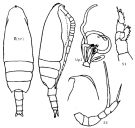 Issued from : K.A. Brodskii in Calanoida of the Far Eastern Seas and Polar Basin of the USSR. Opred. Fauna SSSR, 1950, 35 (Israel Program for Scientific Translations, Jerusalem, 1967) [p.250, Fig.157]. Female (from NW Pacif.): habitus (dorsal and lateral right side); forehead (lateral); Mp1, Mx2; S1, P1; S5, P5.
|
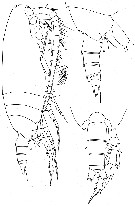 issued from : W. Vervoort in B.A.N.Z. Antarctic Reseach Expedition, Report-Ser. B, Vol. III, 1957 [Fig.100]. Female (from 55°11S, 55°51'E): a, habitus (lateral; b-c, postrior part cephalothorax and urosome (lateral and dorsal, respectively).
|
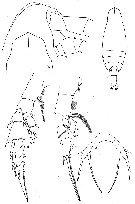 issued from : W. Vervoort in B.A.N.Z. Antarctic Reseach Expedition, Report-Ser. B, Vol. III, 1957 [Fig.101]. Female: a-b, forehead (lateral and dorsal, respectively); c, habitus habitus (dorsal); d, left P2 (posterior); e, right P1 (anterior); f, P5.
|
 issued from : R.N. Wolfenden in Die Marinen Copepoden der Deutschen Südpolar-Expedition 1901-1903, 1911. [p.265, Fig.39]. As Amallophora gracilis. With doubt. Female: a, habitus (lateral); b, P1; c, P5.
|
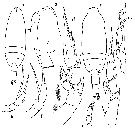 issued from : O. Tanaka in Publ. Seto Mar. Biol. Lab., 1961, IX (1). [p.161, Fig.114]. Female (Japan: Izu Region): a, habitus (dorsal); b, forehead (lateral); c, last thoracic segment and genital segment (lateral, left side); d, P2; e, P5; f, P5 (other specimen). Nota from the example of 5.40 mm length: - Cephalothorax and abdomen in proportional lenths 75 : 25. - Forehead with a median crest. - Last thoracic segment produced into triangular expansion, bluntly pointed at the apex. - Urosome 4 segmented; urosomal segments and caudal rami in proportional lenths 34 : 24 : 21 : 6 : 15 = 100. - Caudal rami 1.8 times as long as broad. - Endopod of A2 about 1.4 times as long as the exopod. - P5 3-segmented, distal segment with 4 spines, of which 2 outer marginal ones are short; the inner marginal spine is about 2 times as long as the 3rd segment itself; the terminal spine is longer than the 3rd segment itself. - Rem.: A specimen (5.30 mm) had P5 with a rudimentary endopod on the inner distal corner of the 2nd segment; its apical spine was much shorter than the distal segment. Another specimen (4.81 mm) had P5 with a rudimentary endopod furnished with an apical spine. Cephalothorax and urosome in proportional lengths 77 : 23. Urosomal segments and caudal rami in proportional lengths 38 : 23 : 18 : 5 : 15 = 100. A1 22-segmented (segments 8 to 10 fused, 24-25 fused), extends to the distal margin of the last thoracic segment, 1st segment with a row fine spinules on the posterior distal margin. Male: g, habitus (dorsal); h, P2; i, endopod of P3; j, P5. Nota: Last thoracic segment broadly rounded inlateral view. - Rostrum with 2 slender filaments. - Abdomen contained 2.6 times in the length of the cephalothorax. - A1 extends a little beyond the distal margin of the 3rd thoracic segment. - Right A1 19-segmented (segments 8 to 12 fused, 12 and 13 partially fused, 20 and 21 fused. - Mx2 soft-skined, bears only long filaments on the distal segment. - Terminal spine of exopod of P2 with 36 teeth. - P5 extends to the distal margin of the 3rd urosomal segment; endopod of right leg long, reaching the distal margin of the 2nd basal segment of the left leg, there is a small process on the proximal part of the endopod; left leg with endopod 2-segmented, slightly longer than the exopod.
|
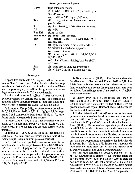 Issued from : C. Razouls in Ann. Inst. océanogr., Paris, 1994, 70 (1). [p.113]. Caractéristiques morphologiques de Scaphocalanus affinis femelle et mâle adultes. Terminologie et abbréviations: voir à Calanus propinquus.
|
 issued from : O. Tzanaka in Publ. Seto Mar. Biol. Lab., 1961, IX (1). [p.162]. Female: Proportional lengths of the segments of A1. Nota: Specimen measuring 4.81 mm had the P5 with a rudimentary endopod furnished with an apical spine. - Cephalothorax and abdomen in the proportional lengths as 77 : 23. - Abdominal segments and caudal rami in the proportional lengths 38 : 23 : 18 : 5 : 15 = 100. - A1 extends to the distal margin of the last thoracic segment; the 1st segment has a row fine spinules on the posterior distal margin. - Mouthparts and swimming legs as in S. affinisThe specimen, though smaller in size than the specimen descibed from the Izu region (5.40 mm), is an example of S. affinis with abnormal P5.
| | | | | Compl. Ref.: | | | Sewell, 1948 (p.502, 514, 521, 526, 527); Mazza, 1966 (p.70); uruhashi, 1966 a (p.295, vertical distribution in Oyashio region, Table 6); Grice & Hulsemann, 1967 (p.16); Roe, 1972 (p.277, tabl.1, tabl.2); Björnberg, 1973 (p.331, 389); Deevey & Brooks, 1977 (p.256, tab.2, Station "S"); Vives, 1982 (p.292); Lozano Soldevilla & al., 1988 (p.58); Madhupratap & Haridas, 1990 (p.305, fig.5: vertical distribution night/day; fig.7: cluster); Gopalakrishnan & Balachandran, 1992 (p.167, figs.1, 7, Table 1, 2); Padmavati & al., 1998 (p.349); Voronina & Kolosova, 1999 (p.71); Lapernat, 2000 (tabl. 3, 4); Razouls & al., 2000 (p.343, tab. 5, Appendix); d'Elbée, 2001 (tabl. 1); Yamaguchi & al., 2002 (p.1007, tab.1); Shimode & al., 2005 (p.113 + poster); Kuriyama & Nishida, 2006 (p.299: Tab.II; p.309: Tab.III, fig.7, 10, vertical distribution); Ikeda & al., 2006 (p.1791, Table 2); Gaard & al., 2008 (p.59, Table 1, N Mid-Atlantic Ridge); Galbraith, 2009 (pers. comm.); Homma & Yamaguchi, 2010 (p.965, Table 2); Homma & al., 2011 (p.29, Table 2, 3, abundance, feeding pattern: detritivores); Sano & al., 2013 (p.11, Table 9, food habits); Belmonte, 2018 (p.273, Table I: Italian zones). | | | | NZ: | 15 + 1 doubtful | | |
|
Distribution map of Scaphocalanus affinis by geographical zones
|
| | | | | | | | | | | |  issued from : W. Vervoort in B.A.N.Z. Antarctic Reseach Expedition, Reports - Ser. B, Vol. III, 1957 [Fig.96]. issued from : W. Vervoort in B.A.N.Z. Antarctic Reseach Expedition, Reports - Ser. B, Vol. III, 1957 [Fig.96].
Chart showing the geographical distribution (white triangle) in the seas surrounding the Antarctic continent.
Nota: In this chart the area frequented by whaling vessels has been hatched. The Antarctic circle (66°.5 S) has been drawn as a broken line. The numbers I to VI refer to the sectors into which the Antarctic seas are divided according to Mackintosh (1942) (after Vervoort, 1951). |
 Issued from : M. Madhupratap & P. Haridas in J. Plankton Res., 12 (2). [p.312, Fig.5]. Issued from : M. Madhupratap & P. Haridas in J. Plankton Res., 12 (2). [p.312, Fig.5].
Vertical distribution of calanoid copepod (mean +1 SE), abundance No/100 m3. 54- Scaphocalanus affinis.
Night: shaded, day: unshaded.
Samples collected from 6 stations located off Cochin (India), SE Arabian Sea, November 1983, with a Multiple Closing Plankton Net (mesh aperture 300 µm), in vertical hauls at 4 depth intervalls (0-200, 200-400, 400-600, 600-1000 m). |
| | | | Loc: | | | ? Antarct. (Weddell Sea, SW Atlant., Indian, SW Pacif.), sub-Antarct. (S Indian, SW Pacif.), Namibia, off Mauritania-NW Cape Verde Is., off Mauritania, Canary Is., off Madeira, Portugal, S Bay of Biscay, off Bermuda: Station ‘’ S’’ (32°10’N, 64°30’W), Sargasso Sea, S Strait of Davis, off SW Ireland, Medit. (Algiers Bay, Adriatic Sea), Indiian (Arabian Sea, off SW Sri Lanka, S Laccadive Is., SW Indian ( 10° N - 10° S )in Gopalakrishnan & Balachandran, 1992), Indonesia-Malaysia, Philippines, Japan, off SE Hokkaido, Station Knot (44°N, 155°E), Kuril-Kamchatka, Bering Sea (Aleutian Basin), S Aleutian Is., off British Columbia, New Zealand, Galapagos, Peru, Pacif. (SE tropical), Chile (N & S) | | | | N: | 40 | | | | Lg.: | | | (1) F: 3,6; (9) F: 5,3-4,6; M: 5; 4,2; (22) Atlant.: F: 3,6; M: 3,5; Pacifique & Antarct.: F: 5,2-5; ? (25) F: 5,36-5,13; M: 4,73; ? (35) F: 5,1-5,05; (108) F: 5,4; M: 4,5; (199) F: 3,88; (1000) F: 4,9 ± 0,5; M: 3,7 ± 0,9; {F: 3,60-5,40; M: 2,80-5,00} | | | | Rem.: | meso-bathypelagic.
Sampling depth (Antarct., sub-Antarct.) : 500-2000 m. Sargasso Sea: 500-2000 m (Deevey & Brooks, 1977, station "S").
Distributional range (m) from Roe (1972): Night: 720 (in Kuriyama & Nishida, 2006).
According to Vyshkvartzeva (pers. comm.) this species is confused by most authors with S. antarcticus Park, 1982 (p.83, 89). Likewise, Hulsemann (1994, pers. comm.) is not convinced that this species and S. antarcticus are not the same. The female P5 shows a fairly pronounced variability.
Farran (1929) points out that the specimen from the Antarctic is less slender than in the figure given by Sars. This latter considers S. gracilis and S. affinis as identical. | | | Last update : 19/01/2021 | |
|
|
 Any use of this site for a publication will be mentioned with the following reference : Any use of this site for a publication will be mentioned with the following reference :
Razouls C., Desreumaux N., Kouwenberg J. and de Bovée F., 2005-2025. - Biodiversity of Marine Planktonic Copepods (morphology, geographical distribution and biological data). Sorbonne University, CNRS. Available at http://copepodes.obs-banyuls.fr/en [Accessed December 03, 2025] © copyright 2005-2025 Sorbonne University, CNRS
|
|
 |
 |














